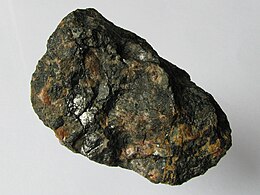| Coffinite | |
|---|---|
 Pitchblende and coffinite in a sample from a Czech mine | |
| General | |
| Category | Nesosilicate |
| Formula (repeating unit) | U(SiO4)1−x(OH)4x |
| IMA symbol | Cof[1] |
| Strunz classification | 9.AD.30 |
| Crystal system | Tetragonal |
| Crystal class | Ditetragonal dipyramidal (4/mmm) H-M symbol: (4/m 2/m 2/m) |
| Space group | I41/amd |
| Unit cell | a = 6.97 Å, c = 6.25 Å; Z = 4 |
| Identification | |
| Color | Black (from organic inclusions; pale to dark brown in thin section |
| Crystal habit | Rarely as crystals, commonly as colloform to botryoidal incrustations, fibrous, pulverulent masses |
| Fracture | Irregular to subconchoidal |
| Tenacity | Brittle to friable |
| Mohs scale hardness | 5–6 |
| Luster | Dull to adamantine |
| Streak | Grayish black |
| Diaphaneity | Opaque, transparent on thin edges |
| Specific gravity | 5.1 |
| Optical properties | Uniaxial (+/−) |
| Refractive index | nα = 1.730–1.750 nβ = 1.730–1.750 |
| Birefringence | δ = 1.730 |
| Pleochroism | Moderate; pale yellow-brown parallel to and medium brown perpendicular to long axis |
| Alters to | Metamict |
| Other characteristics | |
| References | [2][3][4][5][6][7][8][9][10][11][12][13][14] |
Coffinite is a uranium-bearing silicate mineral with formula: U(SiO4)1−x(OH)4x.
It occurs as black incrustations, dark to pale-brown in thin section. It has a grayish-black streak. It has a brittle to conchoidal fracture. The hardness of coffinite is between 5 and 6.
It was first described in 1954 for an occurrence at the La Sal No. 2 Mine, Beaver Mesa, Mesa County, Colorado, US,[5] and named for American geologist Reuben Clare Coffin (1886–1972).[3] It has widespread global occurrence in Colorado Plateau-type uranium ore deposits of uranium and vanadium. It replaces organic matter in sandstone and in hydrothermal vein type deposits.[3] It occurs in association with uraninite, thorite, pyrite, marcasite, roscoelite, clay minerals and amorphous organic matter.[3]
- ^ Warr, L.N. (2021). "IMA–CNMNC approved mineral symbols". Mineralogical Magazine. 85 (3): 291–320. Bibcode:2021MinM...85..291W. doi:10.1180/mgm.2021.43. S2CID 235729616.
- ^ Mineralienatlas
- ^ a b c d Anthony, John W.; Bideaux, Richard A.; Bladh, Kenneth W.; Nichols, Monte C. (2005). "Coffinite" (PDF). Handbook of Mineralogy. Mineral Data Publishing. Retrieved 19 June 2022.
- ^ Webmineral data
- ^ a b Coffinite, Mindat.org
- ^ Stieff, L.R.; Stern, T.W; Sherwood, A.M. (1955). "Preliminary Description of Coffinite – A New Uranium Mineral". Science. 121 (3147): 608–609. Bibcode:1955Sci...121..608S. doi:10.1126/science.121.3147.608-a. hdl:2027/mdp.39015095016906.
- ^ Fuchs, L.H.; Gebert, E. (1958). "X-Ray Studies of Synthetic Coffinite, Thorite and Uranothorites". American Mineralogist. 43: 243–248.
- ^ Stieff, L.R.; Stern, T.W; Sherwood, A.M. (1956). "Coffinite, a Uranous Silicate with Hydroxyl Substitution – A New Mineral". American Mineralogist. 41: 675–688.
- ^ Hansley, P.L.; Fitzpatrick, J.J. (1989). "Compositional and Crystallographic Data on REE-Bearing Coffinite from the Grants Uranium Region, Northwestern New-Mexico". American Mineralogist. 74: 263–270.
- ^ Moench, R.H. (1962). "Properties and Paragenesis af Coffinite from Woodrow Mine, New Mexico". American Mineralogist. 47: 26–33.
- ^ Min, M.Z.; Fang, C.Q.; Fayek, M. (2005). "Petrography and Genetic History of Coffinite and Uraninite from the Liueryiqi Granite-Hosted Uranium Deposit, SE China". Ore Geology Reviews. 26 (3–4): 187–197. doi:10.1016/j.oregeorev.2004.10.006.
- ^ Zhang, F. X.; Pointeau, V.; Shuller, L. C.; et al. (2009). "Response of Synthetic Coffinite to Energetic Ion Beam Irradiation". American Mineralogist. 94: 916–920. doi:10.2138/am.2009.3111. S2CID 73581946.
- ^ Hoekstra, H.R.; Fuchs, L.H. (1956). "Synthesis of Coffinite-USiO4". Science. 123 (3186): 105. Bibcode:1956Sci...123..105H. doi:10.1126/science.123.3186.105.
- ^ Guo X.; Szenknect S.; Mesbah A.; Labs S.; Clavier N.; Poinssot C.; Ushakov S.V.; Curtius H.; Bosbach D.; Rodney R.C.; Burns P.; Navrotsky A. (2015). "Thermodynamics of Formation of Coffinite, USiO4". Proc. Natl. Acad. Sci. USA. 112 (21): 6551–6555. Bibcode:2015PNAS..112.6551G. doi:10.1073/pnas.1507441112. PMC 4450415. PMID 25964321.